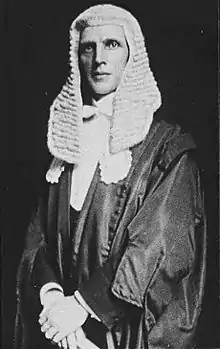Charles Statham
Sir Charles Ernest Statham (10 May 1875 – 5 March 1946) was a New Zealand politician, and the ninth Speaker of the House of Representatives, from 1923 to 1935.
Sir Charles Statham | |
|---|---|
 | |
| 9th Speaker of the House of Representatives | |
| In office 7 February 1923 – 1 November 1935 | |
| Preceded by | Frederic Lang |
| Succeeded by | Bill Barnard |
| Personal details | |
| Born | 10 May 1875 Dunedin, New Zealand |
| Died | 5 March 1946 (aged 70) Wellington, New Zealand |
| Political party | Reform |
Private life
He was born in Dunedin in 1875, and trained in law, practising in his own Dunedin office from 1904. He married the part-Māori Lilias Harata te Aho Burnett of Dunedin in 1905, with whom he later had one daughter.[1]
Political career
| New Zealand Parliament | ||||
| Years | Term | Electorate | Party | |
| 1911–1914 | 18th | Dunedin Central | Reform | |
| 1914–1915 | 19th | Dunedin Central | Reform | |
| 1915–1919 | 19th | Dunedin Central | Reform | |
| 1919–1922 | 20th | Dunedin Central | Independent | |
| 1922–1925 | 21st | Dunedin Central | Independent | |
| 1925–1928 | 22nd | Dunedin Central | Independent | |
| 1928–1931 | 23rd | Dunedin Central | Independent | |
| 1931–1935 | 24th | Dunedin Central | Independent | |
He was on the Dunedin City Council 1911–1915.[1] He was the Reform Party candidate in 1911 in the Dunedin Central electorate and defeated the incumbent, James Arnold of the Liberal Party. Statham held the electorate from 1911 to 1935.[2] He had differences with the Reform party leadership, and was returned as an Independent member in 1919. He represented a city and working-class electorate, and his majority was gradually reduced by the Labour Party. He decided to retire at the 1935 election.[1]
He was Speaker of the House of Representatives from 1923 to 1935. He is one of only three people to have held the office despite not being from the governing party. In 1923, as an independent, but formerly a member of the Reform Party, he was backed by Reform so as not to endanger the party's slim majority, and later retained his position under the United Party. He was described as "probably the greatest speaker the house has known"[3] and many of his rulings still form part of the parliamentary standing orders today.[1] He was fair but firm during a stormy period.[1] His retirement was due to the rising popularity of the Labour Party, and he did not think that he could contest the 1935 election without losing his impartiality, but fighting the election along party-lines would compromise his ability to remain Speaker.[4]
He was created a Knight Bachelor in 1926,[2] and in 1935, he was awarded the King George V Silver Jubilee Medal.[5] He was appointed to the New Zealand Legislative Council on 9 March 1936 and was reappointed seven years later after his term had expired and served until his death.[6] He did not take an active part in politics as a Legislative Councillor, though.[1] He practised law in Wellington after retiring from Parliament, and died there on 5 March 1946. He was survived by his wife and his daughter.[1]
Notes
- Hamer, David. "Statham, Charles Ernest - Biography". Dictionary of New Zealand Biography. Ministry for Culture and Heritage. Retrieved 30 December 2011.
- Scholefield 1950, p. 140.
- Wilson, James Oakley (1966), "STATHAM, Sir Charles Ernest", An Encyclopaedia of New Zealand, edited by A. H. McLintock, retrieved 30 December 2011
- "Mr. Speaker". Auckland Star. LXVI (174). 25 July 1935. p. 9. Retrieved 16 November 2013.
- "Official jubilee medals". Evening Post. CXIX (105). 6 May 1935. p. 4. Retrieved 24 June 2018.
- Scholefield 1950, p. 85.
References
- Scholefield, Guy (1950) [First published in 1913]. New Zealand Parliamentary Record, 1840–1949 (3rd ed.). Wellington: Govt. Printer.
| Political offices | ||
|---|---|---|
| Preceded by Frederic Lang |
Speaker of the New Zealand House of Representatives 1923–1935 |
Succeeded by Bill Barnard |
| New Zealand Parliament | ||
| Preceded by James Arnold |
Member of Parliament for Dunedin Central 1911–1935 |
Succeeded by Peter Neilson |